Huiyuan Chen
Visa Research
Towards Efficient Large Scale Spatial-Temporal Time Series Forecasting via Improved Inverted Transformers
Mar 13, 2025Abstract:Time series forecasting at scale presents significant challenges for modern prediction systems, particularly when dealing with large sets of synchronized series, such as in a global payment network. In such systems, three key challenges must be overcome for accurate and scalable predictions: 1) emergence of new entities, 2) disappearance of existing entities, and 3) the large number of entities present in the data. The recently proposed Inverted Transformer (iTransformer) architecture has shown promising results by effectively handling variable entities. However, its practical application in large-scale settings is limited by quadratic time and space complexity ($O(N^2)$) with respect to the number of entities $N$. In this paper, we introduce EiFormer, an improved inverted transformer architecture that maintains the adaptive capabilities of iTransformer while reducing computational complexity to linear scale ($O(N)$). Our key innovation lies in restructuring the attention mechanism to eliminate redundant computations without sacrificing model expressiveness. Additionally, we incorporate a random projection mechanism that not only enhances efficiency but also improves prediction accuracy through better feature representation. Extensive experiments on the public LargeST benchmark dataset and a proprietary large-scale time series dataset demonstrate that EiFormer significantly outperforms existing methods in both computational efficiency and forecasting accuracy. Our approach enables practical deployment of transformer-based forecasting in industrial applications where handling time series at scale is essential.
A Compact Model for Large-Scale Time Series Forecasting
Feb 28, 2025Abstract:Spatio-temporal data, which commonly arise in real-world applications such as traffic monitoring, financial transactions, and ride-share demands, represent a special category of multivariate time series. They exhibit two distinct characteristics: high dimensionality and commensurability across spatial locations. These attributes call for computationally efficient modeling approaches and facilitate the use of univariate forecasting models in a channel-independent fashion. SparseTSF, a recently introduced competitive univariate forecasting model, harnesses periodicity to achieve compactness by concentrating on cross-period dynamics, thereby extending the Pareto frontier with respect to model size and predictive performance. Nonetheless, it underperforms on spatio-temporal data due to an inadequate capture of intra-period temporal dependencies. To address this shortcoming, we propose UltraSTF, which integrates a cross-period forecasting module with an ultra-compact shape bank component. Our model effectively detects recurring patterns in time series through the attention mechanism of the shape bank component, thereby strengthening its ability to learn intra-period dynamics. UltraSTF achieves state-of-the-art performance on the LargeST benchmark while employing fewer than 0.2% of the parameters required by the second-best approaches, thus further extending the Pareto frontier of existing methods.
Enhancing Distribution and Label Consistency for Graph Out-of-Distribution Generalization
Jan 07, 2025Abstract:To deal with distribution shifts in graph data, various graph out-of-distribution (OOD) generalization techniques have been recently proposed. These methods often employ a two-step strategy that first creates augmented environments and subsequently identifies invariant subgraphs to improve generalizability. Nevertheless, this approach could be suboptimal from the perspective of consistency. First, the process of augmenting environments by altering the graphs while preserving labels may lead to graphs that are not realistic or meaningfully related to the origin distribution, thus lacking distribution consistency. Second, the extracted subgraphs are obtained from directly modifying graphs, and may not necessarily maintain a consistent predictive relationship with their labels, thereby impacting label consistency. In response to these challenges, we introduce an innovative approach that aims to enhance these two types of consistency for graph OOD generalization. We propose a modifier to obtain both augmented and invariant graphs in a unified manner. With the augmented graphs, we enrich the training data without compromising the integrity of label-graph relationships. The label consistency enhancement in our framework further preserves the supervision information in the invariant graph. We conduct extensive experiments on real-world datasets to demonstrate the superiority of our framework over other state-of-the-art baselines.
THeGCN: Temporal Heterophilic Graph Convolutional Network
Dec 21, 2024Abstract:Graph Neural Networks (GNNs) have exhibited remarkable efficacy in diverse graph learning tasks, particularly on static homophilic graphs. Recent attention has pivoted towards more intricate structures, encompassing (1) static heterophilic graphs encountering the edge heterophily issue in the spatial domain and (2) event-based continuous graphs in the temporal domain. State-of-the-art (SOTA) has been concurrently addressing these two lines of work but tends to overlook the presence of heterophily in the temporal domain, constituting the temporal heterophily issue. Furthermore, we highlight that the edge heterophily issue and the temporal heterophily issue often co-exist in event-based continuous graphs, giving rise to the temporal edge heterophily challenge. To tackle this challenge, this paper first introduces the temporal edge heterophily measurement. Subsequently, we propose the Temporal Heterophilic Graph Convolutional Network (THeGCN), an innovative model that incorporates the low/high-pass graph signal filtering technique to accurately capture both edge (spatial) heterophily and temporal heterophily. Specifically, the THeGCN model consists of two key components: a sampler and an aggregator. The sampler selects events relevant to a node at a given moment. Then, the aggregator executes message-passing, encoding temporal information, node attributes, and edge attributes into node embeddings. Extensive experiments conducted on 5 real-world datasets validate the efficacy of THeGCN.
Understanding and Mitigating Memorization in Diffusion Models for Tabular Data
Dec 15, 2024Abstract:Tabular data generation has attracted significant research interest in recent years, with the tabular diffusion models greatly improving the quality of synthetic data. However, while memorization, where models inadvertently replicate exact or near-identical training data, has been thoroughly investigated in image and text generation, its effects on tabular data remain largely unexplored. In this paper, we conduct the first comprehensive investigation of memorization phenomena in diffusion models for tabular data. Our empirical analysis reveals that memorization appears in tabular diffusion models and increases with larger training epochs. We further examine the influence of factors such as dataset sizes, feature dimensions, and different diffusion models on memorization. Additionally, we provide a theoretical explanation for why memorization occurs in tabular diffusion models. To address this issue, we propose TabCutMix, a simple yet effective data augmentation technique that exchanges randomly selected feature segments between random same-class training sample pairs. Building upon this, we introduce TabCutMixPlus, an enhanced method that clusters features based on feature correlations and ensures that features within the same cluster are exchanged together during augmentation. This clustering mechanism mitigates out-of-distribution (OOD) generation issues by maintaining feature coherence. Experimental results across various datasets and diffusion models demonstrate that TabCutMix effectively mitigates memorization while maintaining high-quality data generation.
Matrix Profile for Anomaly Detection on Multidimensional Time Series
Sep 14, 2024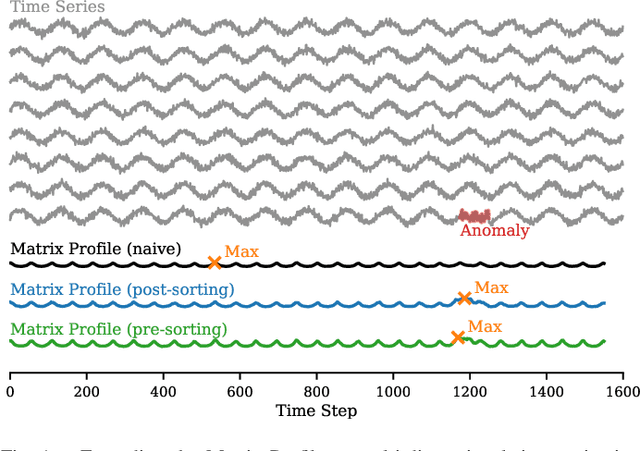
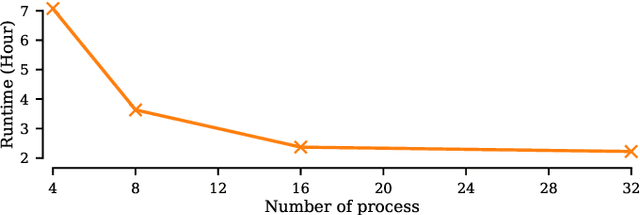
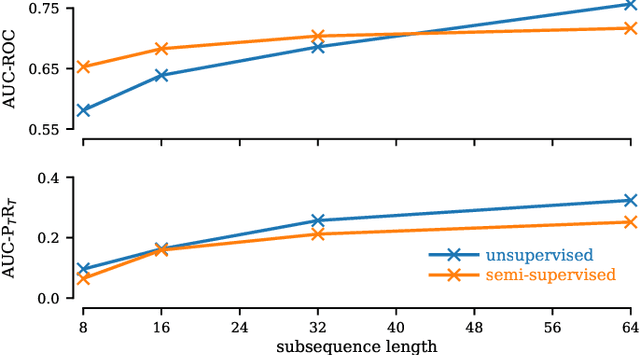
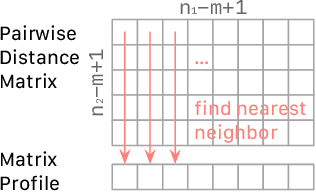
Abstract:The Matrix Profile (MP), a versatile tool for time series data mining, has been shown effective in time series anomaly detection (TSAD). This paper delves into the problem of anomaly detection in multidimensional time series, a common occurrence in real-world applications. For instance, in a manufacturing factory, multiple sensors installed across the site collect time-varying data for analysis. The Matrix Profile, named for its role in profiling the matrix storing pairwise distance between subsequences of univariate time series, becomes complex in multidimensional scenarios. If the input univariate time series has n subsequences, the pairwise distance matrix is a n x n matrix. In a multidimensional time series with d dimensions, the pairwise distance information must be stored in a n x n x d tensor. In this paper, we first analyze different strategies for condensing this tensor into a profile vector. We then investigate the potential of extending the MP to efficiently find k-nearest neighbors for anomaly detection. Finally, we benchmark the multidimensional MP against 19 baseline methods on 119 multidimensional TSAD datasets. The experiments covers three learning setups: unsupervised, supervised, and semi-supervised. MP is the only method that consistently delivers high performance across all setups.
GAIM: Attacking Graph Neural Networks via Adversarial Influence Maximization
Aug 20, 2024Abstract:Recent studies show that well-devised perturbations on graph structures or node features can mislead trained Graph Neural Network (GNN) models. However, these methods often overlook practical assumptions, over-rely on heuristics, or separate vital attack components. In response, we present GAIM, an integrated adversarial attack method conducted on a node feature basis while considering the strict black-box setting. Specifically, we define an adversarial influence function to theoretically assess the adversarial impact of node perturbations, thereby reframing the GNN attack problem into the adversarial influence maximization problem. In our approach, we unify the selection of the target node and the construction of feature perturbations into a single optimization problem, ensuring a unique and consistent feature perturbation for each target node. We leverage a surrogate model to transform this problem into a solvable linear programming task, streamlining the optimization process. Moreover, we extend our method to accommodate label-oriented attacks, broadening its applicability. Thorough evaluations on five benchmark datasets across three popular models underscore the effectiveness of our method in both untargeted and label-oriented targeted attacks. Through comprehensive analysis and ablation studies, we demonstrate the practical value and efficacy inherent to our design choices.
A Systematic Evaluation of Generated Time Series and Their Effects in Self-Supervised Pretraining
Aug 15, 2024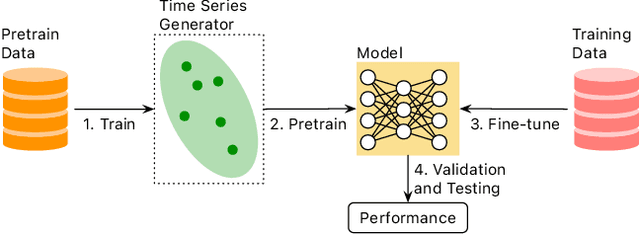



Abstract:Self-supervised Pretrained Models (PTMs) have demonstrated remarkable performance in computer vision and natural language processing tasks. These successes have prompted researchers to design PTMs for time series data. In our experiments, most self-supervised time series PTMs were surpassed by simple supervised models. We hypothesize this undesired phenomenon may be caused by data scarcity. In response, we test six time series generation methods, use the generated data in pretraining in lieu of the real data, and examine the effects on classification performance. Our results indicate that replacing a real-data pretraining set with a greater volume of only generated samples produces noticeable improvement.
SimCE: Simplifying Cross-Entropy Loss for Collaborative Filtering
Jun 23, 2024



Abstract:The learning objective is integral to collaborative filtering systems, where the Bayesian Personalized Ranking (BPR) loss is widely used for learning informative backbones. However, BPR often experiences slow convergence and suboptimal local optima, partially because it only considers one negative item for each positive item, neglecting the potential impacts of other unobserved items. To address this issue, the recently proposed Sampled Softmax Cross-Entropy (SSM) compares one positive sample with multiple negative samples, leading to better performance. Our comprehensive experiments confirm that recommender systems consistently benefit from multiple negative samples during training. Furthermore, we introduce a \underline{Sim}plified Sampled Softmax \underline{C}ross-\underline{E}ntropy Loss (SimCE), which simplifies the SSM using its upper bound. Our validation on 12 benchmark datasets, using both MF and LightGCN backbones, shows that SimCE significantly outperforms both BPR and SSM.
Large Generative Graph Models
Jun 07, 2024Abstract:Large Generative Models (LGMs) such as GPT, Stable Diffusion, Sora, and Suno are trained on a huge amount of language corpus, images, videos, and audio that are extremely diverse from numerous domains. This training paradigm over diverse well-curated data lies at the heart of generating creative and sensible content. However, all previous graph generative models (e.g., GraphRNN, MDVAE, MoFlow, GDSS, and DiGress) have been trained only on one dataset each time, which cannot replicate the revolutionary success achieved by LGMs in other fields. To remedy this crucial gap, we propose a new class of graph generative model called Large Graph Generative Model (LGGM) that is trained on a large corpus of graphs (over 5000 graphs) from 13 different domains. We empirically demonstrate that the pre-trained LGGM has superior zero-shot generative capability to existing graph generative models. Furthermore, our pre-trained LGGM can be easily fine-tuned with graphs from target domains and demonstrate even better performance than those directly trained from scratch, behaving as a solid starting point for real-world customization. Inspired by Stable Diffusion, we further equip LGGM with the capability to generate graphs given text prompts (Text-to-Graph), such as the description of the network name and domain (i.e., "The power-1138-bus graph represents a network of buses in a power distribution system."), and network statistics (i.e., "The graph has a low average degree, suitable for modeling social media interactions."). This Text-to-Graph capability integrates the extensive world knowledge in the underlying language model, offering users fine-grained control of the generated graphs. We release the code, the model checkpoint, and the datasets at https://lggm-lg.github.io/.
 Add to Chrome
Add to Chrome Add to Firefox
Add to Firefox Add to Edge
Add to Edge